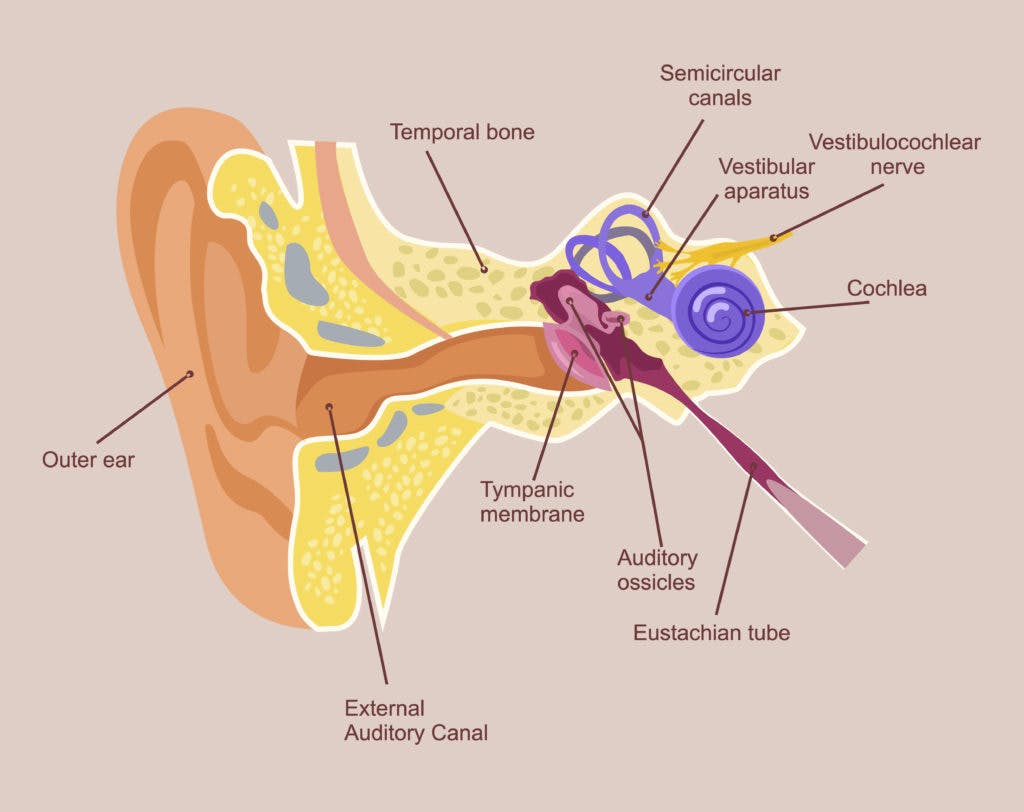Dizziness leads to more than 5 million doctor’s visits in the U.S. each year. Vertigo is a form of dizziness with a sensation of motion without any true motion. This can be a feeling that you are spinning or tumbling. Or the sensation can be a feeling that the room is spinning around you.
About 40% of people with vertigo have positional vertigo. This means your vertigo is triggered when you change position, such as turning over in bed. Benign paroxysmal positional vertigo (BPPV) is the most common form of positional vertigo. Thankfully, BPPV is successfully treated with a series of exercises that your physical therapist will teach you.
What is BPPV?
BPPV is a disorder of the inner ear. It is characterized by repeated episodes of vertigo with changes in position. “Benign” implies that BPPV is not due to any serious disorder. There is an overall favorable prognosis for recovery.
People with BPPV recover without any treatment within 1 month in 20% of cases. Up to 50% will recover within 3 months. Even though recovery rates are high, BPPV significantly impacts your quality of life. It often leads to falls. Your physical therapist will increase your likelihood of a full recovery by teaching you a series of exercises. Read on to learn these exercises.

BPPV occurs when some of the calcium carbonate crystals that are normally embedded in your inner ear become dislodged. This may occur due to an infection, degenerative changes within the crystals, or trauma.
The dislodged crystals migrate into 1 of 3 fluid-filled semicircular canals, where they are not supposed to be. Here, they interfere with the normal fluid movement that these canals use to sense head motion. This causes your inner ear to send false signals to your brain. The false signals from your inner ear do not match the signals that are arriving from your eyes. Your brain becomes confused and produces the sensation of motion or vertigo.
How do you know if you have BPPV?
The following is a list of common characteristics that are consistent with BPPV. If you are experiencing symptoms different than these, please see your doctor before trying any of the re-positioning exercises.
Common characteristics of BPPV:
- Vertigo comes on fast as a result of head movement, such as turning over in bed or bending forward to tie your shoes.
- Symptoms last less than 1 minute.
- Vertigo is characterized by a sense of motion (i.e., the room is spinning)
- Vertigo is absent during periods where the head remains still or motionless.
- Physical therapists confirm the diagnosis of BPPV by performing tests such as the Hallpike-Dix test.
*Important Note: If you are experiencing symptoms of vertigo or dizziness that are not consistent with the above criteria, please see your doctor first.
Re-positioning Exercises for Vertigo
Nine out of 10 people with BPPV respond extremely well to repositioning exercises. Sometimes 1 or 2 treatments are all that is needed. These maneuvers involve a series of position changes guided by your physical therapist. Each position is intended to move the dislodged crystals back to their original location within your inner ear.
Each maneuver takes several minutes and usually causes vertigo. It is best for you to wait for your symptoms to subside before moving into the next position of each exercise. After each exercise, it is common to feel “a little off” for the next few hours. Your physical therapist can help you determine what is normal and what is not.
After performing each maneuver, it is important to follow some guidelines to avoid a quick relapse (go here).
Epley Maneuver
This is the most common and effective treatment for BPPV. The maneuver targets either your left or right ear. Your physical therapist can help you determine which ear is most likely involved.
To treat BPPV of your right ear, begin sitting on your bed. Turn your head 45 degrees to the right. Quickly lie back, keeping your head turned to the right. Support your shoulders on a pillow, and recline your head. Wait 30 seconds or until any symptoms subside.
Then turn your head 90 degrees to the left, without raising it. Your head will now be looking 45 degrees to the left. Wait another 30 seconds or until symptoms subside. Turn your head and body another 90 degrees to the left, into the bed. Wait another 30 seconds or until symptoms subside.
Finally, sit up on the left side of your bed. For left-sided BPPV, complete the same steps starting with your head turned to the left.
Semont Maneuver
In 10% to 20% of cases, the Epley maneuver is not successful. The Semont maneuver is the next line of treatment. It involves rapidly moving from lying on one side to lying on the other side.
Begin seated on the side of your bed. For right-sided BPPV, turn your head 45 degrees toward the left. Then rapidly move to the side-lying position on your right shoulder. Hold this position for approximately 30 seconds. Then rapidly move to the opposite side-lying position without pausing in the sitting position and without changing your head position. Maintain this position for 30 seconds. Last, gradually resume the upright sitting position.
This maneuver will be successful only with rapid movements. If this is difficult for you, try the Brandt-Daroff exercises.
Brandt-Daroff Exercises
The third line of treatment involves a more dedicated approach. The Brandt-Daroff exercises are a little more time-consuming to do. They also generally take several weeks before vertigo fully resolves. Nonetheless, if you are experiencing the classic symptoms of BPPV and you are not responding to the other 2 maneuvers, try these exercises.
Start seated on the side of your bed. Move into the lying position on either side with your nose pointed up at a 45-degree angle. Remain in this position for 30 seconds (or until vertigo subsides, whichever is longer). Then move back to the seated position. Perform the same movement to the opposite side and then sit back up. This completes 1 repetition.
Perform 5 repetitions to each side, at least 3 times per day until symptoms fully resolve. If you are seeing no improvement after 1 week, please contact your physical therapist or doctor.
See Your Physical Therapist for More Help
Vertigo is debilitating and downright scary! But when properly diagnosed, your vertigo can be effectively treated with these exercises. It is important that you are properly diagnosed first. It is best to see your doctor or physical therapist before proceeding with any of these exercises. The physical therapists at BSR have specialized training in vestibular rehabilitation. Give us a call if you would like our help.

